
Session Number: 3
Session Title: International Standards for Income Distribution Statistics
Paper Number: Contributed Paper
Session Organiser: Paul van der Laan
Discussant: –
Paper prepared
for the 26th General Conference of
The International Association for Research in Income and Wealth
Cracow, Poland, 27 August to 2 September 2000
THE INTERNATIONAL EXPERT GROUP ON HOUSEHOLD INCOME STATISTICS (‘CANBERRA GROUP’), 1996-2000
PAUL VAN DER LAAN
For additional
information please contact:
Paul van der Laan
Statistics Netherlands
Division for Social and Spatial Statistics
P.O. Box 4000
2270 JM Voorburg
NETHERLANDS
E-mail:
plan@cbs.nlThis paper is placed on the following websites:
www.stat.gov.pl/THE INTERNATIONAL EXPERT GROUP ON HOUSEHOLD INCOME STATISTICS (‘CANBERRA GROUP’), 1996-2000
Summary
: From 1996 to 2000, an International Expert Group on Household Income Statistics (also known as the ‘Canberra Group’) was active. This paper reviews the objectives of the Group, sketches the meetings and participants and presents the outcomes of the Group. Previous and concurrent efforts relating to international guidelines for income distribution statistics are also briefly reviewed.Keywords: Income distribution statistics; International Expert Group on Household Income Statistics; international comparisons; international guidelines
The initiative
to organise an International Expert Group on Household Income Statistics was
taken by the Australian Bureau of Statistics in order to work on the development
of statistics on household economic well-being and particularly on household
income. The initiative reacted on a growing awareness that, in advancing the
quality of their own household income statistics, National Statistical
Institutes shared many problems. Particularly the comparative OECD study on
income distribution (Atkinson et al. 1995) triggered off a renewed discussion on
the underlying quality and comparability of income data. Expectations were that
combining forces would help solve conceptual and methodological problems, result
in more relevant and reliable national statistics and provide data to be used
for international comparisons on income distribution.
The International Expert Group met for the first time in Canberra, Australia
and, taking its name from the venue of the First Meeting, is known as the
‘Canberra Group’. It follows a now well-established phenomenon of City-named
Expert Groups set up under the auspices of the United Nations Statistical
Commission. The tradition started with the Voorburg Group on service statistics,
which was first set up in 1986 and first met in Voorburg, the Netherlands, in
January 1987. According to the United Nations Statistical Commission the role of
City Group is (United Nations 1999):
The next section reviews the objectives of the Canberra Group. Section 3 sketches the meetings and participants of the Group. Previous and concurrent efforts to produce international guidelines for income distribution statistics are briefly described in section 4. Section 5 summarises the session on session on International Standards on Income and Wealth Distribution at the 24th General Conference General Conference of the International Association for Research in Income and Wealth. Finally, section 6 discusses the achievements of the Group.
The primary
objective of the Canberra Group was enhancing national household income
statistics by developing standards on conceptual and practical issues which are
related to the production of income distribution statistics. Its work was in
support of a revision of international guidelines on income distribution
statistics. The Group would address collectively the common conceptual,
definitional and practical problems faced by national and international
statistical agencies in this subject area and would act as a forum for expert
opinions on conceptual and methodological issues and for obtaining endorsement
for guidelines. A combined approach to solving these conceptual and
methodological problems would result not only in improved national statistics,
but also in improved data for international comparisons on household income
distribution.
Economic analysts and policy-makers identify three main purposes for compiling
information on income distribution. The first one is driven by a desire to
understand the pattern of income distribution and how this can be related to
relative factor endowments and their efficiency and to the way in which
societies are organised, i.e. to theoretical and institutional considerations.
The second one reflects the concern of policy-makers to assess the impact of
national and socially targeted actions on different socio-economic groups. The
third one is an interest in how different patterns of income distribution
influence household well-being and people’s ability to acquire the goods and
services they need to satisfy their needs. The Canberra Group was motivated by
the need to produce statistics that fulfil these purposes.
The Canberra Group was designed to be a flexible working group of experts in household income statistics from both national and international organisations. Members of the Group included representatives from national statistical agencies, government departments and research agencies from Europe, North and South America, Asia, Australia and New Zealand as well as from a number of international organisations and research agencies. All members attended as experts rather than official representatives of their organisations. A central tenet of all City Groups is that their members take part in a personal capacity without necessarily committing their employers.
From December 1996 to May 2000 the Canberra Group met four times. Over 70 participants from 26 national organisations and 7 international organisations were involved in the work of the Canberra Group (See Appendix 3). Reports of the First, Second and Third Meeting of the Canberra Group were published in February 1997, May 1998 and November 1999 respectively (See International Expert Group on Household Income Statistics 1997, 1998 and 1999). The Report is the Fourth Meeting is forthcoming (International Expert Group on Household Income Statistics 2000).
Before the International Expert Group on Household Income Statistics started its activities, a number of - partly overlapping - efforts were undertaken to produce international guidelines on income distribution statistics or to improve the existing ones.
Income distribution statistics were first on the agenda of the United Nations Statistical Commission at its Fourteenth Session in 1966. Subsequently, a system of distribution statistics was gradually developed by the United Nations Statistical Office, which covered income, consumption and accumulation of households and was tied in with both the United Nations System of National Accounts (SNA) and the by now obsolete System of Balances of the National Economy (MPS).
The United Nations Statistical Commission adopted a final version of the full system at its Seventeenth Session in 1972. However, the Commission requested that amendments and simplifications be made in the light of its discussions. A draft of the simplified system was presented to the Commission at its Eighteenth Session in 1974 and was adopted with a number of reservations. In particular, the Commission felt that further simplification was desirable.
After careful consideration, the United Nations Statistical Office concluded that it would be desirable to combine the full and the simplified versions of the Guidelines and present them in a single publication. So, the Provisional Guidelines on Statistics of the Distribution of Income, Consumption and Accumulation of Households were published by the Statistical Office of the United Nations in 1977 (United Nations 1977). Their aim was to assist developed and developing countries to collect and disseminate income distribution statistics and to provide for international reporting and publication of comparable data. The guidelines emphasised the need to link micro-level income distribution statistics with macro-level national accounting standards. Surveys of national practices of income distribution statistics have been published by the United Nations Statistical Office in 1981 and 1985 (United Nations 1981 and 1985).
The 1977 Provisional Guidelines were to be revised concurrently with the 1968 SNA (See e.g. Norrlof 1985). Particularly, the Conference of European Statisticians (CES) started off work on the revision of the 1977 Provisional Guidelines. The CES organised a number of Work Sessions and Seminars to discuss Statistics of household income to develop statistics of the types, sources and distribution of income. Special attention was paid to the relevance of the revision of the SNA (See e.g. United Nations 1989). After all, the revision process of the 1968 SNA had led to advances in conceptual thinking about the household sector and about the concept of income in particular. However, due to limited resources progress in the revision of the 1977 Provisional Guidelines was slow.
In 1994, with the agreement of the United Nations Economic Commission for Europe (ECE) and the Organisation for Economic Co-operation and Development (OECD), EUROSTAT, the Statistical Office of the European Communities, undertook to play a major role in the revision of the 1977 Provisional Guidelines. The key objective was to update the Guidelines in the light of the revised SNA and European System of Accounts (ESA) and new developments since 1977 relating to household income statistics (e.g. hidden and informal activities) and to extend and adapt them where appropriate to serve the analytic needs of economic and social policies. To steer the revision process an Advisory Income Steering Group (AISG) was installed (See e.g. Barreiros and Ramprakash 1996). The work on the revision of the 1977 Provisional Guidelines was carried out by three EUROSTAT consultants (Alfred Franz, Deo Ramprakash and John Walton). However, the geographical scope of the revised guidelines would initially be the countries of the European Economic Area.
In addition, as a result of the 15th International Conference of Labour Statisticians in October 1993 the Bureau of Statistics of the International Labour Organization (ILO) took the initiative to improve the measurement of income from employment (See e.g. Dupré 1997). In October 1998, the 16th International Conference of Labour Statisticians (ICLS) adopted a Resolution concerning the measurement of employment-related income (ILO 1998b).
A general feature of most of the approaches to create international guidelines on income distribution statistics is, that they principally started from a macro view, proceeding from the SNA. However, the top-down macro-to-micro approach to conceptual issues falls short of the perspectives of most micro-data users. Moreover, the inherent flexibility of micro-data reduces the need for an accounting framework. Consequently, these kind of guidelines have a lack of practical advice to the producers and users of micro-data. This is perhaps the main reason, why the 1977 Provisional Guidelines found little acceptance with producers of income distribution statistics and remained provisional.
In what was thus a virtual vacuum of international consensus on how income distribution could and should be measured, concern grew in many countries to develop better measures of the economic well-being of their populations for national policy purposes. The range of survey and other information expanded, and technological advances considerably improved the possibilities for sophisticated treatment of complex micro-data. At the same time, there was an increasing desire to make international comparisons of such statistics. At the inter-country level, the Luxembourg Income Study (LIS) was set up in 1983 to address the lack of comparability of household income data from different countries. Located in the Centre for Population, Poverty and Socio-Economic Policy Studies in Luxembourg, LIS draws together unit record data from a wide range of countries and attempts to reorganise them to a common set of concepts and definitions. However, organisations such as World Bank, United Nations and OECD all published inter-country comparisons during the 1990s in which the same country might have very different relative rankings depending on the concepts and data sources used.
The 24th General Conference of the International Association for Research in Income and Wealth (IARIW) at Lillehammer, Norway in August 1996 included a session on International Standards on Income and Wealth Distribution organised by Tim Smeeding (Smeeding 1996). This session mainly focussed on efforts to revise the 1977 Provisional Guidelines on Statistics of the Distribution of Income, Consumption and Accumulation of Households (United Nations 1977). The session had two keynote papers:
The first paper contained the early results of the work of the EUROSTAT consultants. The second paper was the results of the Australian Bureau of Statistics aimed to define a conceptual ‘map’ as a basis for further development of statistics relating to the economic well-being of households and for facilitating better dialogue between users and producers of such statistics, both nationally and internationally.
Once again, one of the main conclusions from the discussions during this session was that the top down macro-to-micro approach was not sufficient from the perspective of micro-data users. Both micro-to-micro and micro-to-macro viewpoints are valuable and the new international guidelines should address these issues. So, a clear challenge emerged from the 1996 IARIW Session. Integration of theory and application would be difficult but not impossible: any revision of the UN Provisional Guidelines on income distribution statistics should serve both purposes. However, a wider constituency of interest needed to be engaged in the discussions, particularly from National Statistical Institutes, but also from a range of other national and international organisations. Hence the birth of the Canberra Group.
The papers to be presented in the Session on International Standards for Income Distribution Statistics of the 26th General Conference of the IARIW in Cracow, Poland are the result of the joint work by the Canberra Group on Household Income Statistics. Some have already been through a number of drafts as a result of discussions in the Group, others are of more recent origin as the Group has identified missing elements in what will eventually be presented to the UN Statistical Commission as a draft guide to the preparation of income distribution statistics. All papers are intended to guide compilers and hence data analysts and other users on how to prepare harmonised and comparable statistics on income distribution. They represent a synthesis of prevailing ideas and try to reconcile the dual concerns to be faithful to the conceptual nature of income and its theoretical definition, whilst taking into account the practical difficulties of data collection and compilation including the costs involved both to the agencies producing the statistics and to the households and agencies providing the raw material.
The aim of the Canberra Group is to lay down useful guidelines for understanding the complex nature of income data, set in the context of prevailing ideas and best practices. These reflect how economic societies are organised and people conduct their lives. Over the passage of time, with social and political transformation, changes in the role of government, globalisation and so on, economic issues and priorities are necessarily subject to a process of continuous change. It is thus essential to retain a certain degree of flexibility in developing any general classification scheme which is designed to conform to a particular statistical paradigm. The papers produced by the Group deal with some of the most important questions and the guide of which they will form part is designed to be pragmatic. These guidelines are aimed at those attempting to construct different measures of income when confronted by a range of policy contexts, socio-economic conditions and alternative data sources. They also suggest some ways in which income data can be put together, analysed dynamically and disseminated.
One of the guiding principles of the Group has been that, in order to gain the wide acceptance which previous efforts in this field have lacked, every constituency and stakeholder which seeks to promote comparability should have an input into the goals and principles on which the guide should be built. Thus the purpose of the IARIW Session on International Standards for Income Distribution Statistics is to expose the work of the Group to scrutiny by a wider audience of experts in the field. The Group hopes that the discussion will enable further improvement and refinement of the drafts.
Box 1. Contents of the draft guidelines on income distribution statistics
I INTRODUCTION
Preface
Chapter 1 Executive Summary
II ESTABLISHING THE CONCEPTS
Chapter 2 Overview of conceptual
issues
Chapter 3 Reconciliation of micro-macro concepts and terminology
Chapter 4 Practical issues and criteria for choosing definitions
III PRODUCING AND USING INCOME DISTRIBUTION STATISTICS
Chapter 5 Options for practical
definitions
Chapter 6 Cross-country comparisons of income distributions
Chapter 7 Time series data for the distribution of income
Chapter 8 The dynamics of income distribution
Chapter 9 Quality assessment
Chapter 10 Data presentation issues
IV ISSUES FOR FUTURE DEVELOPMENT
Chapter 11 Economic and social
transformations
Chapter 12 The radar screen
The papers to be presented in the IARIW Session in Cracow form a sub-set of the chapters of the final product of the Canberra Group. The full content of the final product is set out in Box 1. This product will be a draft guide to compilers and analysts on the preparation of harmonised and comparable statistics on income distribution. The draft guide will be presented for endorsement to the UN Statistical Commission early in 2001. If, as the Canberra Group hopes, the draft compendium is endorsed by the UN Statistical Commission, its work will be over and it will disband. The true test of how effectively it has fulfilled its remit will then be in the extent to which the guide is taken up and used by national and international statistical agencies.
As section IV of the draft guide will make clear, the Group is already aware of a range of issues that remain unresolved and underdeveloped. Some of these may be suitable for consideration by new City Groups. The socio-economic and policy contexts in which statistics of economic well-being are required will continue to change and evolve. Data sources and the tools available for their analysis will also continue to develop. Thus these guidelines, in common with all other such statistical standards, will need to be periodically updated in the same way as is the System of National Accounts.
References
Atkinson, Anthony B., Lee Rainwater and Timothy M. Smeeding. 1995. Income Distribution in OECD Countries: Evidence from the Luxembourg Income Study. Social Policy Studies No. 18. Paris: OECD.
Australian Bureau of Statistics (ABS). 1995. A Provisional Framework for Household Income, Consumption, Saving and Wealth. Canberra, ACT: ABS. June 1995.
Barreiros, M. Lidia Conde de Artiaga and Deo Ramprakash. 1996. ‘Revision of the UN Guidelines on Statistics of the Distribution of Income, Consumption and Accumulation of Households’. Paper prepared for the Twenty-fourth General Conference of the International Association for Research in Income and Wealth. Lillehammer, Norway, 19-23 August 1996.
Dupré, Marie-Thérèse. 1997. ‘The Current Status of the Concept of Income from Employment and Its Relationship with Existing Income Concepts’. Paper prepared for the Advisory Income Steering Group. Statistical Office of the European Communities, Directorate of Social and Regional Statistics and Structural Plans. Luxembourg, 13–14 January 1997. Document AISG/5/1997.
Franz, Alfred. 1996a. ‘Revision of the UN Guidelines on Statistics of the Distribution of Income, Consumption and Accumulation of Households’. Paper prepared for the Twenty-fourth General Conference of the International Association for Research in Income and Wealth. Lillehammer, Norway, 19-23 August 1996.
––––––––––. 1996b. ‘Manual on the Distribution of Income, Consumption and Accumulation of Households’. Report prepared for the Advisory Income Steering Group. Statistical Office of the European Communities, Directorate of Social and Regional Statistics and Structural Plans. Luxembourg, 13-14 January 1997. Document AISG/3/1997.
––––––––––. 1997. ‘The Household Economy’. Report prepared for the Advisory Income Steering Group. Statistical Office of the European Communities, Directorate of Social and Regional Statistics and Structural Plans. Luxembourg, 13–14 January 1997. Document AISG/2/1997.
—————, Deo Ramprakash and John W.S. Walton. 1998. ‘Statistics on the Distribution of Income, Consumption and Accumulation of Households (DICAH)’. Report to EUROSTAT. Vienna, London and Luxembourg. August 1998. Mimeographed.
ILO (International Labour Organization). 1979. An Integrated System of Wages Statistics: A Manual on Methods. Geneva: International Labour Office.
––––––––––. 1994. Household Income and Expenditure Surveys. Sources and Methods: Labour Statistics, Vol. 6. Geneva: International Labour Office.
—————. 1998a. Measurement of Income from Employment. Report prepared for the Sixteenth International Conference of Labour Statisticians. Geneva, Switzerland, 6-15 October 1998. ICLS/16/1998/II.
—————. 1998b. Final Report of the Sixteenth International Conference of Labour Statisticians, Geneva, Switzerland, 6-15 October 1998. Geneva: International Labour Office.
International Expert Group on Household Income Statistics (‘Canberra Group’). 1997. Papers and Final Report of the First Meeting on Household Income Statistics, Canberra, Australia, 2–4 December 1996. Belconnen, ACT: Australian Bureau of Statistics. February 1997.
—————. 1998. Papers and Final Report of the Second Meeting on Household Income Statistics, Voorburg, The Netherlands, 9-11 March 1998. Voorburg and Heerlen: Statistics Netherlands. May 1998.
––––––––––. 1999. Papers and Final Report of the Third Meeting on Household Income Statistics, Ottawa, Ontario, Canada, 7-9 June 1999. Ottawa, Ontario: Statistics Canada. November 1999.
––––––––––. 2000. Papers and Final Report of the Fourth Meeting on Household Income Statistics, Differdange, Luxembourg, 15-17 May 2000. Differdange, Luxembourg: Luxembourg Income Study at CEPS/INSTEAD. Forthcoming.
Norrlof, Claes. 1985. ‘Issues in the Revision of the International Income Distribution Guidelines’. Paper prepared for the Nineteenth General Conference of the International Association for Research in Income and Wealth. Noordwijkerhout, Netherlands, 25-31 August 1985.
Ramprakash, Deo. 1997. ‘Revision of the UN Guidelines on Statistics of the Distribution of Income, Consumption and Accumulation of Households: Framework Issues’. Report prepared for the Advisory Income Steering Group. Statistical Office of the European Communities, Directorate of Social and Regional Statistics and Structural Plans. Luxembourg, 13–14 January 1997. Document AISG/4/1997.
Smeeding, Timothy M. 1996. ‘The IARIW Session on International Standards on Income and Wealth Distribution: A Summary’. Paper prepared for the First meeting of the International Expert Group on Household Income Statistics. Canberra, ACT, 2-4 December 1996.
United Nations, Department of Economic and Social Affairs, Statistical Office. 1977. Provisional Guidelines on Statistics of the Distribution of Income, Consumption and Accumulation of Households. Studies in Methods, Series M, No. 61. New York, NY: United Nations. ST/ESA/STAT/SER.M/61.
—————, Department for Economic and Social Information and Policy Analysis, Statistical Division. 1998a. Household Accounting: Experiences in the Use of Concepts and Their Compilation. Vol. 1, Household Sector Accounts. Studies in Methods, Handbook of National Accounting, Series F, No. 75. New York, NY: United Nations. ST/ESA/STAT/SER.F/75.
––––––––––, ––––––––––, ––––––––––. 1998b. Household Accounting: Experiences in the Use of Concepts and Their Compilation. Vol. 2, Household Satellite Extensions. Studies in Methods, Handbook of National Accounting, Series F, No. 75. New York, NY: United Nations. ST/ESA/STAT/SER.F/75.
—————, Department of International Economic and Social Affairs, Statistical Office. 1981. A Survey of National Sources of Income Distribution Statistics. Studies in Methods, Series M, No. 72. New York, NY: United Nations. ST/ESA/STAT/SER.M/72.
––––––––––, ––––––––––, ––––––––––. 1985. National Accounts Statistics: Compendium of Income Distribution Statistics. Statistical Papers, Series M, No. 79. New York, NY: United Nations. ST/ESA/STAT/ SER.M/79.
—————, Economic and Social Council, Statistical Commission. 1999. ‘Report of the ad hoc Group established by the Statistical Commission: Note by the Secretary-General’. Thirtieth Session. New York, NY, 1-5 March 1999. E/CN.3/1999/23, 6 August 1998.
—————, —————, ————— and United Nations Economic Commission for Europe, Conference of European Statisticians. 1989. ‘Items in the Revision of the SNA which are Relevant from the Point of View of Statistics of Income of Households: Note by the Secretariat’. Work Session on Statistics of the Distribution of Income of Households, Working Paper No. 3. Geneva, 25-27 September 1989.
Walton, John W.S. 1996. ‘Towards a Revision of the UN Guidelines on Statistics of the Distribution of Income, Consumption and Accumulation of Households’. Paper prepared for the Twenty-fourth General Conference of the International Association for Research in Income and Wealth. Lillehammer, Norway, 19-23 August 1996.
––––––––––. 1997. ‘Links between Micro-Level Concepts of Income and the National Accounts’. Report prepared for the Advisory Income Steering Group. Statistical Office of the European Communities, Directorate of Social and Regional Statistics and Structural Plans. Luxembourg, 13–14 January 1997. Document AISG/1/1997.
Appendix 1. Important dates regarding international guidelines on household income statistics
1966 Fourteenth Session of the United Nations Statistical Commission: Start of the work on international guidelines on statistics on the distribution of income, consumption and accumulation of households
1972 Seventeenth Session of the United Nations Statistical Commission: Adoption of the final version of the full system of statistics on the distribution of income, consumption and accumulation of households
1973 Twelfth International Conference of Labour Statisticians organised by the International Labour Organization, Bureau of Statistics: Adoption of a Resolution concerning Household income and expenditure surveys
1974 Eighteenth Session of the United Nations Statistical Commission: Adoption of the simplified version of the system of statistics on the distribution of income, consumption and accumulation of households
1975 Publication by the United Nations Statistical Office of the document Towards a System of Social and Demographic Statistics, a comprehensive technical report prepared by Richard Stone
1977 Publication by the United Nations Statistical Office of the Provisional Guidelines on Statistics of the Distribution of Income, Consumption and Accumulation of Households
1981 Publication by the United Nations Statistical Office of A Survey of National Sources of Income Distribution Statistics in which information was provided on the latest available sources of income distribution statistics for 60 countries
1985 Publication by the United Nations Statistical Office of National Accounts Statistics: Compendium of Income Distribution Statistics which provided information from 57 countries on sources of income distribution statistics and country tables presenting income distribution tabulations
August 1987 Fourth Expert Group Meeting on the Revision of the SNA: The Household Sector
September 1989 Work Session on Statistics of the distribution of income of households organised by the United Nations Economic Commission for Europe, Conference of European Statisticians
July 1991 Seminar on Statistics of household Income organised by the United Nations Economic Commission for Europe, Conference of European Statisticians
1993 Publication of the System of National Accounts 1993
May 1995 Publication by the OECD of the study Income Distribution in OECD Countries: Evidence from the Luxembourg Income Study by Tony Atkinson, Lee Rainwater and Tim Smeeding which presented a comparison of income distribution in OECD countries
June 1995
First Meeting of the Advisory Income Steering Group on Statistics on the
Distribution of Income, Consumption and Accumulation of Households (DICAH)
Publication by the Australian Bureau of Statistics of A Provisional Framework
for Household Income, Consumption, Saving
and Wealth
June 1996 Regulation on the European System of Accounts (ESA 1995) approved by the Council of the European Union
August 1996 Twenty-fourth General Conference of the International Association for Research in Income and Wealth, including a Session on International standards on income and wealth distribution organised by Tim Smeeding
December 1996 First Meeting of the International Expert Group on Household Income Statistics (‘Canberra Group’)
January 1997 Second Meeting of the Advisory Income Steering Group on Statistics on the Distribution of Income, Consumption and Accumulation of Households (DICAH)
October 1997
Meeting of Experts on Labour Statistics on the Measurement of income from
employment organised by the International Labour Organization, Bureau of
Statistics
Expert Group Meeting on Household satellite accounting organised by the United
Nations Statistics Division
March 1998 Second Meeting of the International Expert Group on Household Income Statistics (‘Canberra Group’)
August 1998 Publication of the Report to EUROSTAT on Statistics on the Distribution of Income, Consumption and Accumulation of Households (DICAH)
October 1998 Sixteenth International Conference of Labour Statisticians organised by the International Labour Organization, Bureau of Statistics: Adoption of a Resolution concerning the Measurement of employment-related income
May 1999 Seminar on Income distribution and different sources of income organised by the Subcommittee on Social Statistics of the European Advisory Committee on Statistical Information in the Economic and Social Spheres
June 1999 Third Meeting of the International Expert Group on Household Income Statistics (‘Canberra Group’)
December 1999 Seminar on Household Income Statistics organised by the Statistical Office of the European Communities
May 2000 Fourth and Final Meeting of the International Expert Group on Household Income Statistics (‘Canberra Group’)

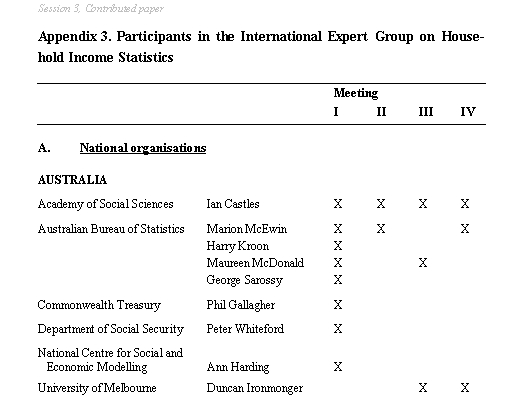
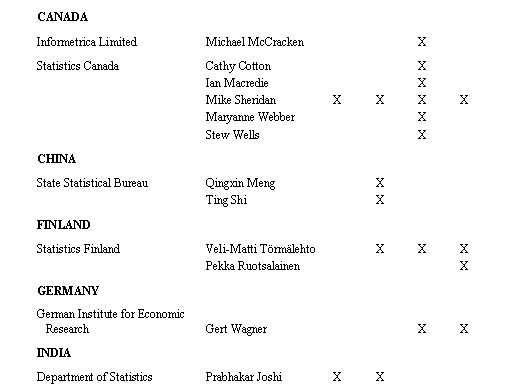

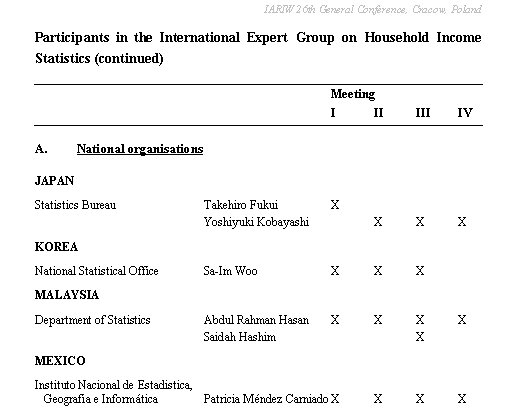
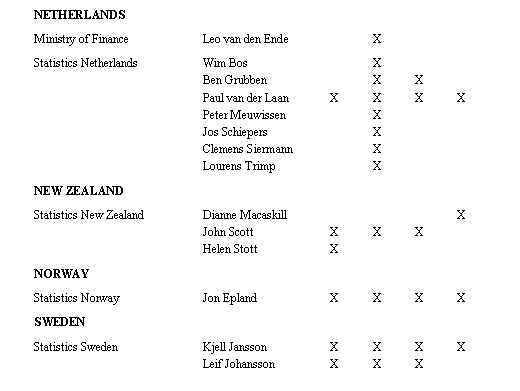
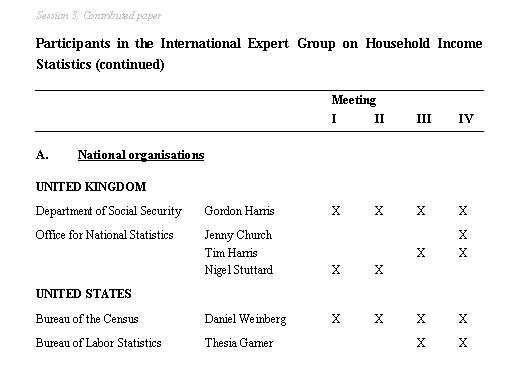

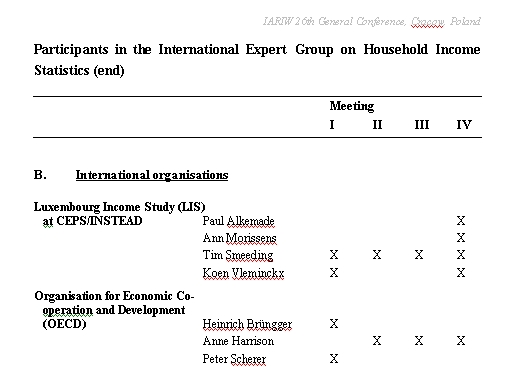

-----------------------------------------------
The reports and papers of the Meetings are also available on the Canberra Group’s web site on the Internet which is maintained by the Luxembourg Income Study. The Canberra Group homepage is: http://www.lis.ceps.lu/canberra.htm.
The AISG met two times, on 19 June 1995 and on 13-14 January 1997.
Revisions of these papers were discussed at the January 1997 meeting of the Advisory Income Steering Group (See Franz 1996b and 1997, Ramprakash 1997 and Walton 1997). At the Voorburg meeting of the Canberra Group in March 1998 a preliminary version of the report on ‘Statistics on the Distribution of Income, Consumption and Accumulation of Households (DICAH)’ was presented by EUROSTAT consultants Alfred Franz and John Walton. A final draft of the DICAH report was presented to EUROSTAT in August 1998 (See Franz et al. 1998).